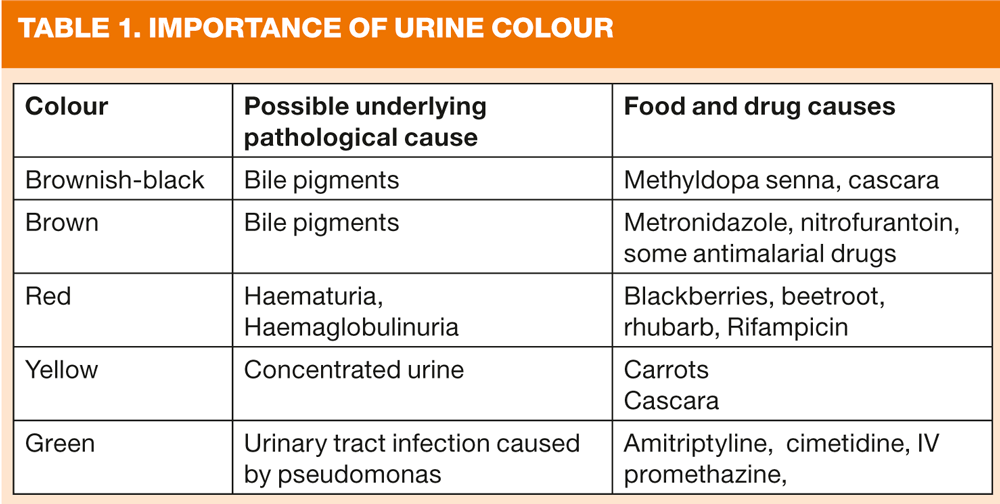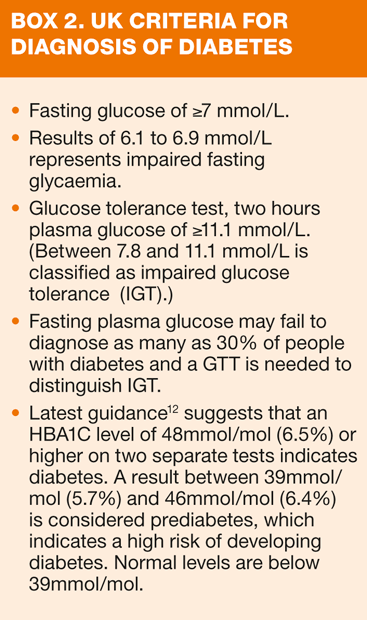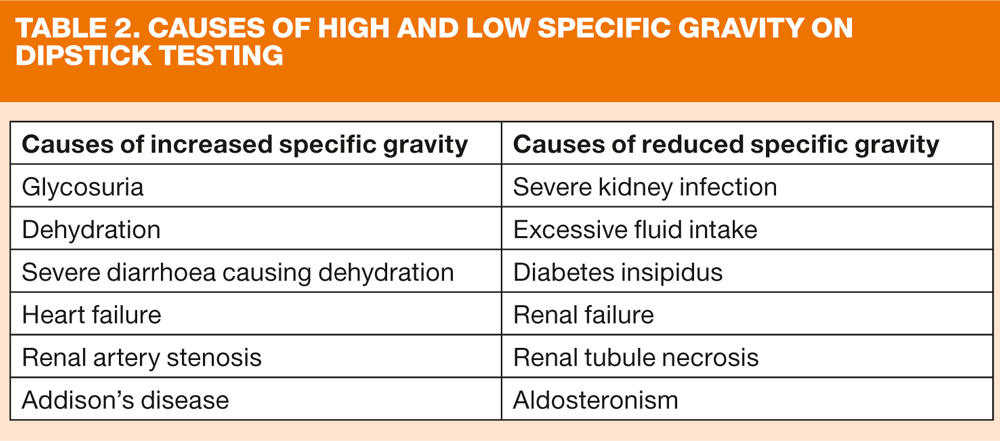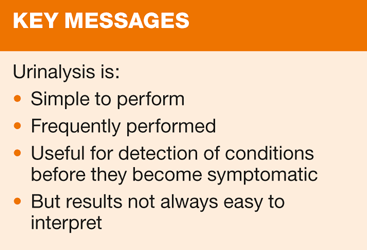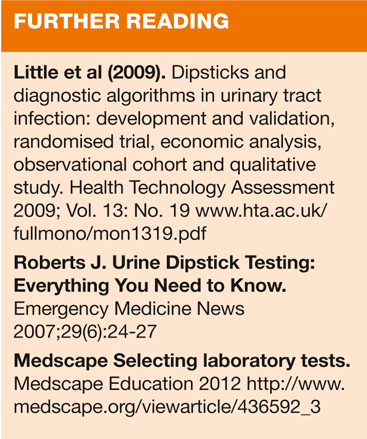Urinalysis — when, why and what does it mean?
Margaret Perry
Margaret Perry
RGN BSc(Hons) MSC
Advanced Nurse Practitioner, Linkway
Medical Practice, West Bromwich
One of the most common tasks for the practice nurse is to test patients' urine samples — but what can this simple test reveal about the patient's condition?
Urine testing is a frequently performed task, which many practice nurses do on a daily basis. The test is easy to perform, inexpensive and although simple, interpretation of the results is not always easy, as there are many factors to take into account when assigning a meaning to any abnormalities detected. The test can provide a wealth of information and can be very useful in the diagnosis of previously undiagnosed conditions.
HEALTHY KIDNEYS AND URINE
The kidneys are highly specialised organs, which have a key role in maintaining a healthy internal environment, which they achieve by excreting or reabsorbing specific substances in accordance to the exact requirements of the body. The kidneys are responsible for urine formation.
Urine is a very complex fluid comprised of 95% water and 5% solids.1 Each kidney contains approximately one million nephrons and it is within these nephrons that the removal of wastes takes place. Within each nephron there is a capillary network — the glomerulus — which acts as a sieve excreting fluid and wastes and retaining substances needed by the body. On a daily basis, large quantities of blood pass through the kidneys producing approximately one and a half litres of urine per day. Once formed, urine is transported by the ureters to the bladder where it is stored until it is eliminated from the body through the urethra.
WHEN IS URINALYSIS REQUESTED?
The test may be undertaken as part of routine screening to assess for previously undiagnosed problems or requested for patients presenting with specific symptoms to exclude a particular condition.
ASSESSMENT PRIOR TO TESTING
Before dipstick testing the urine a wealth of information can be gleaned from assessing the colour, transparency and any unusual odour that may be apparent.
Colour
The normal colour of urine is pale yellow or amber but this may be darker or lighter depending on how concentrated or diluted the sample is. In addition to this the colour can be greatly affected by a number of factors including certain foods, medications and the presence of a urinary tract infection. Table 1 shows some of the causes of abnormal coloured urine.
Turbidity
Patient will often present with a cloudy sample of urine and there are several reasons which may account for this. A sample from a female patient may be contaminated with vaginal mucus or epithelial cells or in the presence of a urinary tract infection, pus in the urine will produce the same effect. Cloudy urine can also occur as a result of precipitated phosphate crystals in alkaline urine or may be found in patients whose diet is rich in purine.2 Box 1 lists some foods rich in purine.
Odour
Freshly voided urine has virtually no smell. Concentrated urine may have a smell but this does not necessarily imply infection is present however when a urinary tract infection is present the urine often has an offensive pungent smell. Little and colleagues3 reported urine smell as highly predictive of urinary tract infection with an 82% accuracy.
WHAT DOES URINE TESTING DETECT?
The urine dipstick test detects the presence of a number of parameters and results can point towards underlying pathology requiring further investigation. Abnormal findings are a warning that something may be wrong and in general, the greater the concentration of the atypical substance, such as glucose or protein, the more likely it is that there is a problem that needs to be addressed.4 The test is particularly useful for detecting conditions at an early stage, such as diabetes, which can be picked up before the patient has developed symptoms.
TESTING THE SAMPLE
A dipstick is immersed into a fresh sample of urine and retained for approximately one second before removing. Excess urine should be removed from the test strip by drawing it across the rim of the sample container. Colour changes on the strip are then observed after a specified time period of 30-60 seconds.
INTERPRETATION
Blood
Blood is not normally present in the urine therefore any detected on dipstick testing is abnormal. Blood in the urine (haematuria) is usually asymptomatic but will cause the urine to have a reddish colour, more pronounced if there are a large number of red blood cells in the sample. The commonest cause of blood in the urine in the UK is cystitis although any blood found in the urine whether visible or non visible should be investigated.5 One of the chief concerns is that estimates indicate that one in twelve adults with non visible blood in the urine and one in five with visible blood are subsequently found to have bladder cancer.5
Protein
Protein molecules are too large for filtration through the glomeruli and therefore the presence of protein in the urine is indicative of an underlying problem. Usually there are no symptoms but if the protein loss is heavy, the urine has a frothy appearance, and may be associated with oedema of the hands feet or abdomen.6 Patient with diabetes are at risk of developing proteinuria and in both type 1 and type 2 diabetes protein detected in the urine is one of the first signs of deteriorating kidney function.
Another risk factor for proteinuria is hypertension, which can have serious consequences if the blood pressure remains uncontrolled when progression to renal failure is possible. People of African Caribbean descent have a higher incidence of hypertension than their white counterparts7 and have also been found to have a higher incidence of end stage renal failure.8
Nitrites
In healthy people the urine should be clear of nitrites, but when the urine becomes infected, most species of bacteria are able to colonise in the urine producing nitrates that are then converted to nitrites. The presence of nitrite is highly specific for bacteria, but several pathogens do not reduce nitrate to nitrite, and therefore its utility is restricted to infections caused Enterobacteria, which give a positive test result.9
Ketones
Ketone bodies are usually present in urine and blood of healthy individuals, but in very low concentrations and are not normally detectable on dipstick testing. In patients with diabetes, the presence of ketones in the urine is a warning sign of poor control and indicates that the body is burning fat to obtain energy rather than glucose. This is a potentially serious condition which can lead to diabetic coma or even death. Although ketonuria is most commonly associated with uncontrolled diabetes, it also can occur during pregnancy, carbohydrate-free diets, and starvation.12
Glucose
Glucose detected in the urine (glycosuria) is caused by one of two possible problems. In healthy individuals most of the glucose in the blood is reabsorbed and is not excreted in the urine. In diabetes where blood glucose levels can be abnormally high, the kidneys are unable to reabsorb it all, so some is excreted via the kidneys. Another possible cause is kidney dysfunction where the renal tubules cannot absorb the amount of glucose which they should be able to do. The finding of glucose in the urine should therefore be followed up with further investigations to assess for diabetes. Box 2 shows the diagnostic criteria.
Acidity
Urine pH can range from 4.5 to 8 but is normally slightly acidic.2 Eating certain foods in the diet can make urine more acidic — protein and acidic fruits such as cranberries, while diets high in citrate such as fruits, fish, green leafy vegetables and wholegrains can make the urine alkaline. Urine pH is important in urinary tract infections because most of the bacteria responsible for these infections make the urine more alkaline because the bacteria split urea into ammonia and other alkaline waste products.1
Specific gravity
Urinary specific gravity measurement is a routine part of urinalysis, giving a measure of the concentration of solutes in the urine, therefore providing information on the kidney's ability to concentrate urine.10 There are a number of conditions which can cause specific gravity to be either elevated or reduced. These are shown in Table 2.
Leucocytes
Leucocytes are white blood cells which when detected in the urine suggest urinary tract infection.11 Positive results in dipstick testing have a reported sensitivity of 75-90% but are not valid in patients with neutropenia.
Culture and sensitivity
If urinary tract infection is suspected a sample could be sent to the laboratory for culture and sensitivity, although this is not generally done routinely as the results would not change management for the majority of patients, and routine testing is not therefore considered cost effective, except for certain groups e.g. children. If a urine sample is thought necessary, a midstream sample of urine is preferred which requires that the first part of the sample is passed into the toilet, the middle portion collected in the sample bottle and the final portion passed into the toilet. Collecting the middle portion is thought to provide an accurate picture of urine within the bladder as any bacteria from the urethra are washed away when the first early urine is voided.
CONCLUSION
It is clear that there is a wealth of information to be learned from urine testing and results can give useful information on a wide range of conditions. Understanding the parameters gives practice nurses the skills and knowledge to recognise when further investigations are needed and by being able to do this nurses can only be improving future health outcomes.
REFERENCES
1. Habel M Understanding urinalysis RNCeus 2012 http://www.rnceus.com/ua/uaframe.html
2. Simerville J.A , William M.D. Maxted C, and Pahira J.J American Family Physician. 2005 Mar 15;71(6):1153-1162.
3. Little P., Turner S., Rumsby K., Warner G., Moore M., Lowes J.A Smith H., HawkeC., Turner D., Leydon G.M., Arscott A and Mullee M (2009) Dipsticks and diagnostic algorithms in urinary tract infection: development and validation, randomised trial,economic analysis, observational cohort and qualitative study. Health Technology Assessment 2009; Vol. 13: No. 19 www.hta.ac.uk/fullmono/mon1319.pdf
4. American Association for Clinical Chemistry (2009) Lab tests online: Urinalysis http://labtestsonline.org/understanding/analytes/urinalysis/tab/test
5. The British Association of Urological Surgeons (2012) Blood in the urine. http://www.baus.org.uk/patients/symptoms/haematuria
6. National Kidney and Urologic Diseases Information Clearinghouse (2012) Proteinuria http://kidney.niddk.nih.gov/kudiseases/pubs/proteinuria/#symptoms
7. Primatesta P, Bost L, Poulter NR. Blood pressure levels and hypertension status among ethnic groups in England. J Human Hypertens 2000; 14:143—8
8. Raleigh VS, Kiri V, Balarajan R. Variations in mortality from diabetes mellitus, hypertension and renal disease in England and Wales by country of birth. Health Trends1997; 28:122—7
9. Franz M and Horl W. Common errors in diagnosis and management of urinary tract infection. I: Pathophysiology and diagnostic techniques. Nephrol. Dial. Transplant 1999;14(11): 2746-2753
10. Lin J Specific Gravity Medscape reference 2011 http://emedicine.medscape.com/article/2090711-overview#showall
11. National Kidney Federation Urinary Infections 2011 http://www.kidney.org.uk/Medical-Info/kidney-disease/urinfect.html
12. Diabetes UK (2012) Care recommendations: New diagnostic criteria for diabetes (Jan 2011). Use of Haemoglobin A1c (HbA1c) in the diagnosis of diabetes mellitus in the UK http://www.diabetes.org.uk/About_us/Our_Views/Care_recommendations/New_diagnostic_criteria_for_diabetes_/
Related articles
View all Articles

